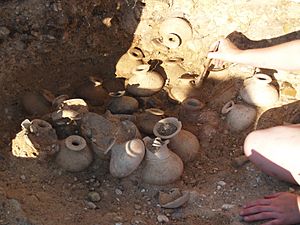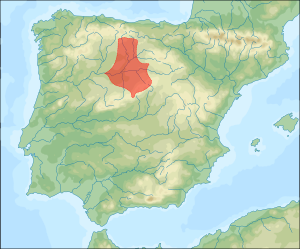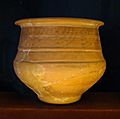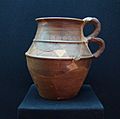Vaccaei facts for kids
The Vaccaei (say: Vack-AY-ee) were an ancient Celtic group who lived in what is now Spain. They lived before the Romans arrived. The Vaccaei made their home in the flat lands of the central Duero valley, in a region called the Meseta Central in northern Hispania. Today, this area is known as Castile and León. Their main city was called Intercatia, located near modern-day Paredes de Nava.
Contents
Who Were the Vaccaei?
The Vaccaei were mostly of Celtic origin, and they were likely related to the Celtiberians. Some old writings called them Vaccaenas. One idea is that their name comes from a Celtic word, vacos, which means 'slayer'. This might be because they were known as strong fighters. However, other experts think their name might come from an old river name, Ceia, combined with a word meaning 'water'.
The Vaccaei often worked together with their neighbors, the Celtiberi. This suggests they might have been part of the larger Celtiberian group of peoples. They had a very fair society where everyone was equal. They shared land and food among all their people. This way of life was common among many ancient groups in Hispania, including the Vettones, Lusitani, Cantabri, and Astures.
Vaccaei Culture and Life

Archaeologists have learned a lot about the Vaccaei by studying their settlements. They are linked to the 'Douro Culture' from the second Iron Age. This culture grew from an earlier one called 'Soto de Medinilla'. At places like Pintia (now Padilla de Duero), people have lived continuously since very ancient times, even before the Iron Age.
The Vaccaei were considered one of the most advanced groups west of the Celtiberians. They had a special way of organizing their society that helped them farm the land very well. They were especially good at growing wheat and grass on the western plateau.
Vaccaei Beliefs
Like the Arevaci, another ancient group, the Vaccaei had a unique custom for their fallen warriors. They would leave the bodies of warriors who died in battle out in the open. Vultures, which they saw as sacred birds, would then consume the bodies. This practice is called excarnation.
Where Did the Vaccaei Live?
The Vaccaei lived in the middle of the northern Meseta, on both sides of the Duero River. Their main city was Pallantia, which might be modern-day Palencia or Palenzuela. An ancient writer named Ptolemy listed about twenty towns in their area. These included important places like Helmantica (now Salamanca), Arbucala (now Toro), Pintia (Padilla de Duero), Intercatia (Paredes de Nava), and Cauca (Coca).
It's hard to say exactly where their borders were, as they changed over time. But their land covered all of the province of Valladolid. It also included parts of León, Palencia, Burgos, Segovia, Salamanca, and Zamora. To the northwest, the Cea and Esla rivers separated them from the Astures. To the east, the Pisuerga and Arlanza rivers marked their border with the Turmodigi. The Arevaci were their neighbors and friends to the south and southeast.
Vaccaei History and Conflicts
The Vaccaei were a strong warrior people. In the 5th century BC, they moved to the western and southwestern parts of the Iberian Peninsula with other groups like the Arevaci. In the early 3rd century BC, they helped the smaller Turmodigi people gain freedom from the Autrigones.
The Vaccaei first appeared in written history around the late 3rd century BC. In 221-220 BC, they teamed up with the Carpetani and Olcades. They tried to stop Hannibal from attacking their lands. But Hannibal's army, the Carthaginians, defeated them at the battle on the Tagus. The cities of Salmantica and Arbucala then fell to the Carthaginians.
The Vaccaei did not seem to take part in the 2nd Punic War. However, in 193-192 BC, they joined forces with the Carpetani, Vettones, and Celtiberians. This combined army was defeated by the Roman Consul Marcus Fulvius at the battle of Toletum. Later, in 179 BC, they were again beaten by the Roman Praetor Lucius Postumius Albinus.
During the Celtiberian Wars, the Vaccaei supported their neighbors, the Arevaci. The Romans punished them with military campaigns led by generals like Lucius Licinius Luculus (151-150 BC) and Quintus Caecilius Metellus Macedonicus (142 BC). After the Roman destruction of Numantia in 134-133 BC, the Vaccaei were officially under Roman control. They became part of the Hispania Citerior province.
However, the Vaccaei continued to fight for their freedom. During the Sertorian Wars, they supported Quintus Sertorius, a Roman general who rebelled against Rome. Many Vaccaei towns stayed loyal to Sertorius even after he died. In 74 BC, the Roman general Pompey attacked the Vaccaei capital, Pallantia. He also stormed the city of Cauca. The Vaccaei rebelled again in 57-56 BC with the Turmodigi and northern Celtiberians, but this uprising was crushed. Their last rebellion was in 29 BC, just before the Astur-Cantabrian wars. They were finally subdued by Consul Titus Statilius Taurus.
Becoming Roman
The Vaccaei lands later became part of the new Hispania Terraconensis province, created by Emperor Augustus in 27 BC. Over time, the Vaccaei people joined the Roman way of life. Some Vaccaei even became soldiers in the Roman army, serving in a cavalry unit called Ala II Flavia Hispanorum civium romanorum. This unit was stationed at a Roman fort called Petavonium (near Rosinos de Vidriales).
A Name Mix-Up
In the early Middle Ages, some writers mistakenly called the Basques by the names Vaccaei and Vacceti.
Images for kids
See also
 In Spanish: Vacceos para niños
In Spanish: Vacceos para niños
- Arevaci
- Belgae
- Bellovaci
- Cantabrian Wars
- Celtiberian Wars
- Celtiberian script
- Sertorian Wars
- Pre-Roman peoples of the Iberian Peninsula








